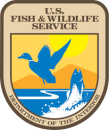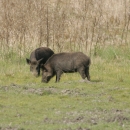Location
States
ArizonaEcosystem
DesertIntroduction
Havasu National Wildlife Refuge (Havasu NWR or refuge) protects 37,515 acres of both riparian riparian
Definition of riparian habitat or riparian areas.
Learn more about riparian areas and desert uplands adjacent to the lower Colorado River in Arizona and California. Approximately half of the Havasu NWR is designated as wilderness. Riparian areas on the refuge are important habitat for migratory and resident bird species such as the Yuma Ridgway's rail (Rallus obsoletus yumanesis), southwesten willow flycatcher (Empidonax traillii extimus), and the western yellow-billed cuckoo (Coccyzus americanus). These federally listed species and many other species use the refuge for a variety of purposes including as a migratory stopover, breeding ground, overwintering site, and year-round habitat.
Feral swine (Sus scrofa) were introduced to North America in the 1500s as a food source by early explorers and settlers, who practiced free-range management of swine. Through escapes from domestic ownership and enclosures and possible releases by hunters as hunting stock, their populations rapidly expanded due to their high adaptive capacity and lack of competition, leading to established populations of invasive feral swine in 41 states. Feral swine were likely introduced to Havasu NWR around 1900 from farms, hunters, and a nearby ranch in Needles, California. The feral swine population at Havasu NWR causes destruction of wetland habitat, direct loss of wildlife, and damage to human infrastructure through their movements and feeding behaviors.
Havasu NWR staff, U.S. Fish and Wildlife Service (USFWS), and USDA’s Animal and Plant Health Inspection Service-Wildlife Services (APHIS) began collaborating in 2016 to eradicate feral swine on Havasu NWR in accordance with the National Feral Swine Damage Management program, a nationwide plan initiated by APHIS to eliminate feral swine populations across the United States.
Key Issues Addressed
Feral swine threaten native species and their habitats within Havasu NWR. They compete with native species for food, habitat, and water, which reduces biodiversity by decreasing resource availability for native species. Through their rooting, trampling, digging, and wallowing behaviors, feral swine destroy native vegetation and erode and compact soils. Destruction of native vegetation allows for invasive plants to spread, which further reduces the abundance of native vegetation, degrades the quality of ecosystem services such as sediment trapping, and destroys habitat for native wildlife. This vegetation is necessary for migratory birds and other animals that rely on the unique wetland, riparian, and desert habitat on the refuge. Feral swine damage nests of ground nesting species such as the endangered Yuma Ridgway's rail when they trample native vegetation and expose nests. Feral swine further threaten native wildlife by consuming reptiles and amphibians, and have been documented to directly predate eggs and birds, though the magnitude of this behavior on Havasu NWR is unknown.
Feral swine also damage infrastructure such as fences, roads, and agricultural fields. Nationwide, they cause at least $1.5 billion dollars in damages per year to human infrastructure, including private property and agriculture. At Havasu NWR, feral swine destroy roads and agricultural fields while rooting and tearing through fences, which require funding to repair. They also exhibit aggressive behaviors such as charging visitors and staff at Havasu NWR. Additionally, feral swine can carry approximately 70 different diseases and parasites that are transmissible to humans, wildlife, and livestock. To date, four diseases have been documented in feral swine from Havasu NWR: Leptospirosis, Salmonella, Escherichia coli (STEC), and Swine Brucellosis. All are transmittable to mammals, including humans. Notably, the same strain of E. coli that has caused periodic outbreaks on lettuce was found in feral swine on Havasu NWR.
Project Goals
- Improve habitat quality for native wildlife by reducing impacts of feral swine
- Improve public safety and protect human infrastructure by eradicating feral swine from Havasu NWR
- Increase public awareness of the negative effects of feral swine on Havasu NWR
Project Highlights
- Eradication Methods: Between 2017 and 2020, seven culling efforts have been conducted on Havasu NWR. Eradication methods include aerial and ground culling, use of hunting dogs, corral traps, and snares. Areas with the highest density of feral swine are targeted for aerial culling. Feral swine are shot by trained APHIS staff to adhere to the USFWS and APHIS policy of humaneness when eradicating animals. By policy and for the safety of scavengers, APHIS and USFWS staff use only non-lead ammunition. Due to the risk of disease transmission, hunting swine for human consumption is not permitted.
- Tracking: Partners use motion-sensor trail cameras to track feral swine throughout the refuge. During ground hunts, night vision and Forward-Looking Infrared (FLIR) devices aid in locating feral swine at night when they are more active. Partners also used “Judas swine”, typically female swine fixed with radio collars, that are released to lead hunters to feral swine social groups.
- Understanding Source Populations: APHIS personnel collect blood and tissue samples for disease and genetic analysis. DNA is analyzed against various reference populations (such as varieties of domestic pigs and wild boars) and added to the APHIS Feral Swine Genetic Archive in order to understand the ancestral origins of the Havasu NWR population and sources of possible recent introductions.
- Community Engagement: Physical closure notices and staff members stationed at refuge entrances are tools used to educate and alert the public when areas are undergoing active cullings. Additionally, signage posted in heavily-trafficked areas of the refuge informs the public about Havasu NWR’s feral swine eradication efforts and encourages visitors to contact refuge staff if feral swine are spotted. Local newspapers published articles about the ongoing eradication efforts to inform the public, and local law enforcement agencies assisted with securing safety perimeters.
Lessons Learned
Near Eradication: As of September 2020, 239 swine had been killed in eradication efforts, and zero swine were spotted during the aerial culling operation that month.
The feral swine population on Havasu NWR occupies riparian habitat surrounded by desert upland with limited water resources beyond the Colorado River. These factors geographically isolate the feral swine population and limit the possibility of non-human caused introductions, increasing the feasibility of complete eradication from the refuge.
For successful eradication, multiple culling efforts within a year are required to respond to feral swine as they adapt quickly to hunting by increasing reproduction and avoiding hunters. As of September 2020, 239 feral swine have been killed, the majority by aerial culling. Although zero swine were spotted in the latest aerial culling effort in September 2020, suggesting near eradication, some swine still remain on Havasu NWR as evidenced by tracks and wallows. However, signs of their activity are spotted far less often than they were before eradication efforts. The use of helicopters for aerial cullings is especially important because staff do not need to navigate through dense, low-visibility vegetation on the ground, increasing their efficiency. Feral swine learned to avoid helicopters and disappear into vegetation, but prescribed fires and cutting or flattening of cattails using a “Marsh Master” decreased available cover for them to hide. To minimize recreational closures for refuge visitors and reduce disturbance to nesting birds, aerial culling efforts are strategically planned around the waterfowl hunting and bird nesting seasons.
Corral traps were not effective at capturing feral swine at Havasu NWR. Most areas of the refuge could not be accessed easily on foot to set up traps and an effective bait was never found to lure them in, despite many ‘recipes’ that work in other parts of the country. “Judas swine” were also not successful, as only one live female was caught in a snare over the course of the project, and it slipped the tracking collar less than a week after being released.
The involvement of APHIS was critical because they provided funding, personnel, equipment and expertise to perform aerial cullings, a crucial strategy for successful eradication.
Next Steps
The remaining feral swine on Havasu NWR will be difficult to encounter because they are typically older, wiser, and better able to avoid culling efforts. However, the cullings must continue because sows can carry 8-12 piglets, so the population can quickly increase if left unchecked. Future monitoring efforts include the addition of more trail cameras and reliance on staff and public sightings of feral swine. Planned culling efforts include additional aerial cullings, ground hunts, and snares to eliminate the last few swine on the refuge. Through participation in the National Feral Swine Damage Management program, partners hope their methods can be applied to other areas with invasive feral swine.
Funding Partners
- USDA-Animal Plant Health Inspection Service-Wildlife Services National Feral Swine Damage Management Program
- U.S. Fish and Wildlife Service, Havasu National Wildlife Refuge
- U.S. Fish and Wildlife Service Arizona Invasive Species Strike Team
Resources
- Havasu National Wildlife Refuge
- Havasu National Wildlife Refuge Feral Swine Eradication Plan
- APHIS National Feral Swine Damage Management Program
- USDA-Animal Plant Health Inspection Service-Wildlife Services
- U.S. Fish and Wildlife Service, Havasu National Wildlife Refuge
- U.S. Fish and Wildlife Service Arizona Invasive Species Strike Team
Contacts
- Brenda Zaun, Zone Biologist, Southwest Arizona National Wildlife Refuge Complex, USFWS: brenda_zaun@fws.gov
- John Bourne, Biologist, Havasu National Wildlife Refuge: john_bourne@fws.gov
CART Lead Authors
- CART Student Writers: Robin Bradley & Nicole Williams (University of Arizona) and Leah Wilson (Northern Arizona University)
- Brenda Zaun (USFWS)
Suggested Citation
Bradley, R., Williams, N., Wilson, L., and Zaun, B. (2021). “Feral Swine Removal from Havasu National Wildlife Refuge.” CART. Retrieved from https://www.fws.gov/project/feral-swine-removal-refuge.







